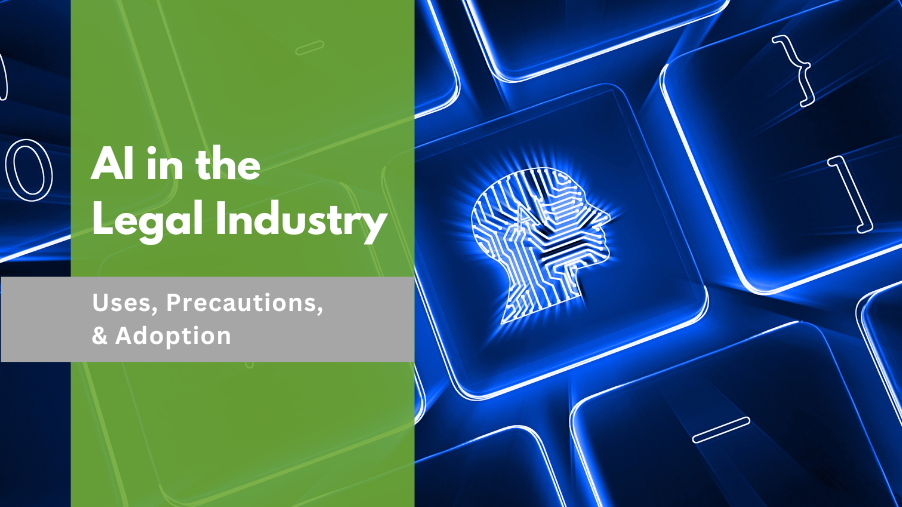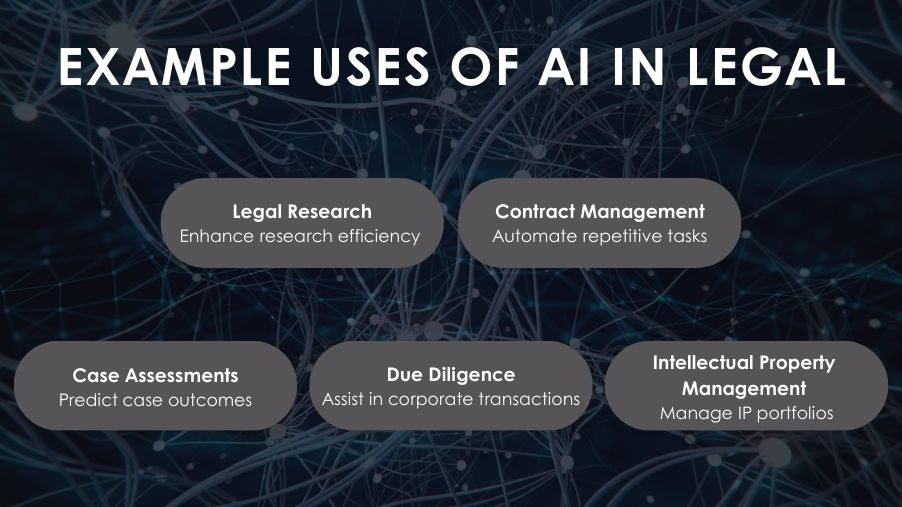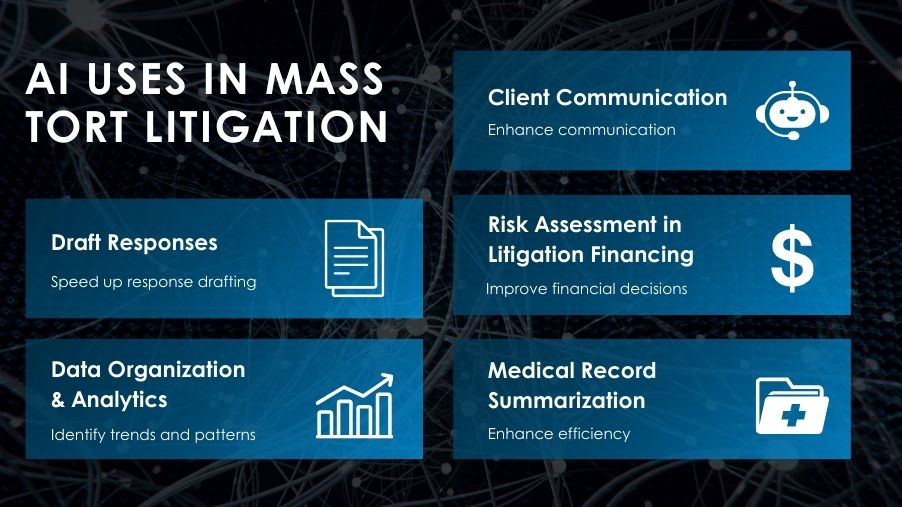
Every industry is buzzing about the use and misuse of AI.
AI can best be described as the use of machines that have been programmed to replicate human intelligence, and essentially, perform tasks that require cognition.
AI can help legal professionals by streamlining processes, improving efficiency, and enhancing legal services. However, it is best with human oversight to mitigate potentially erroneous data – at least for now. Advances in AI are constant.
Example Uses of AI in Legal
- Legal Research
- Contract Management
- Case Assessments
- Due Diligence
- Intellectual Property Management

Legal Research
Can enhance research efficiency. Platforms can be used to analyze legal databases, statutes, regulations, and case law, and then provide relevant insight to the end users, the attorneys, and the paralegals. These tools work best with human oversight.
Contract Management
Can generate standard contracts and agreements, automate the repetitive tasks that lawyers and paralegals are doing, and allow them to focus on more high-end analysis and tasks.
Case Assessments
Case assessments can also benefit from AI. AI tools and algorithms that can predict case outcomes are based on historical data. Lawyers can use those predictions to make more informed decisions regarding strategy.
Due Diligence
Another use of AI in the legal industry is due diligence in corporate mergers, acquisitions, and other business transactions. AI can assist with due diligence by analyzing documents and identifying potentially critical information for the attorneys who are conducting due diligence, mergers, and acquisitions.
Intellectual Property (IP) Management
AI is starting to help law firms and corporate counsel manage IP portfolios by doing things such as tracking patent filings, identifying potential infringements, and other related tests.
AI Uses in Mass Tort Litigation
Mass tort litigation presents unique scenarios, particularly those involving injury. For example, in a mass tort case with a manufacturer that is facing multiple lawsuits related to a single product, there could be myriad different discovery requests in each of the different lawsuits or cases.
- Draft Responses
- Data Organization & Analytics
- Client Communication
- Risk Assessment in Litigation Financing
- Medical Record Summarization
Draft Responses
AI can use prior discovery responses to draft responses or objections to new requests, which can save attorneys a lot of time in the mass torts context with so many parties involved.
Data Organization & Analytics
AI can help organize and analyze data sets across entire plaintiff populations and potentially identify trends or patterns that may not have been seen or noticed easily by human reviewers. Identifying patterns such as specific types of injury that may have been caused by exposure or a product can also help attorneys make informed and data-driven decisions when developing their legal strategies.
Client Communication
Tools such as chatbots can help enhance client communication when a firm is representing a large inventory of litigants. Chatbots and virtual assistance can provide case status updates to clients, answer common questions, and improve overall client satisfaction.
Risk Assessment in Litigation Financing
Third-party funders are increasingly being used in mass tort litigation. They can use AI and natural language processing tools for financial risk assessment purposes. For example, they might be able to analyze a law firm's track record and key success probabilities to make more informed investment decisions.
Medical Record Summarization
In mass tort cases, attorneys need to analyze a lot of medical records, sometimes thousands of pages of medical records. AI can assist by helping sort through this volume to identify dates or keywords. Human review is typically advised and recommended with this process. There are challenges still being presented by medical and other uniquely complex record sets.
Importance of Accurate Data Capturing in Mass Tort Litigation for AI Use
Accurate data is the foundation of any solid information management strategy, including the application of any form of AI. Data accuracy leads to more reliable and therefore more effective results.
- Training Data
- Trust & Decision-Making
- Robustness & Resilience
- Cost Efficiency
- Legal & Ethical Considerations
Training Data
AI models typically learn from data via training. If the training data is not accurate or has any form of bias, the resulting performance will likewise be biased or inaccurate. Biased data can lead to discriminatory AI systems. For example, bias training data can result in biased predictions related to race, gender, and sometimes other sensitive attributes.
Trust & Decision-Making
Trust in AI depends on its accuracy. Inaccurate results would erode the trust and confidence of end users including attorneys, practitioners, and paralegals. This is increasingly important as AI is being used every day for increasingly critical decision-making.
Robustness & Resilence
Consider the robustness and resilience related to data sets. The more data there is within a data set, either accurate or unrelated, the harder the AI must work, and therefore, the harder it is for the AI system to perform well.
Cost Efficiency
Cost efficiency can be a key factor in AI tools. Training is typically involved in AI, requiring computational resources and time. Inaccurate data wastes computational resources, and training time and can require additional time to retrain or review for accuracy.
Legal & Ethical Considerations
Reliance on incorrect data could lead to errors which can have legal and ethical ramifications. Consider hallucinations, where AI tools attempt to “fill in gaps” where data may be missing or incomplete. If AI tools hallucinate and create fake or inaccurate case citations, the results may lead to legal and/or ethical ramifications, including fines or sanctions.
Precautions to Take When Utilizing AI Tools
AI can offer significant benefits, but it can also present challenges. Although technology is advancing every day, AI is not currently an all-encompassing solution. We are excited to see what lies ahead, but for now, there are still risks and limitations, and human oversight is still necessary in many contexts. It’s critical for lawyers and firms to make informed decisions, and to be cautious of buzzwords and marketing that may over-promise and under-deliver.
There are also ethical concerns. It's not always easy to have insight into how an AI tool is functioning, but fairness, transparency, and accountability are all still important in the practice of law and business best practices. Without transparency, there can be ethical issues.
When exploring AI tools or partnerships with AI service providers, inquire about the strategies used for keeping data accurate, clean, and normalized for the best results. Reputable businesses can and will offer insight not only into their own tools but also best practices for getting the most accurate data.
Using AI in Legal: Key Takeaways
- Don’t panic. AI will change the way we work but will not obviate the need for lawyers and legal practitioners.
- AI will change the way that we practice and maybe even the way that we live, but there will be risks and there will be change. As we continue to navigate completely new territories, there is a need for checks and balances, human oversight, and effective advocacy.
- Use AI tools wisely and understand the risks. AI is a tool, not a replacement for legal expertise. Lawyers still need to interpret results generated by AI, consider ethical implications, and manage overall case strategy.
- Technology changes are rapid, and legal practitioners must stay informed of changes in AI. Legal practitioners need to be aware of those tools and what they can do to help, or those that can pose significant risks.
- Try AI tools for yourself and test the waters. Ask other peers how they are using AI tools successfully or where they're running into issues. The more you try out the tools, the more you will find ways to use them. IMPORTANT: Always remember to keep data privacy top of mind and make sure you understand what the tools are doing with your data before you start entering potentially sensitive information or client data.
Strong Partnerships
A partnership is critical when exploring technology options to manage mass tort litigation. Legal practitioners and their clients must understand the risks and the ramifications of not collecting data in a way that provides the ability for AI to do the things that they intended it to do.
LMI cares deeply about delivering clarity and insights during the most challenging and complex situations. Efficiencies are delivered through our proprietary technology platforms. Visit our Legal Software & Data Analytics page to learn more.
To learn more about leveraging technology in mass tort litigation, subscribe to Litigate with Insight, the LMI Podcast.
Dive deeper into the complex world of mass tort litigation and how legal AI is transforming the landscape for attorneys and legal professionals.
Click below to listen to our podcast episode on leveraging legal AI with Megan Pizor, LMI's General Counsel & Chief Data Officer, and Angela Browning, LMI's Chief Strategy Officer, as they discuss the challenges of managing mass tort cases, the role of artificial intelligence in streamlining processes, and practical strategies for leveraging AI tools effectively.

